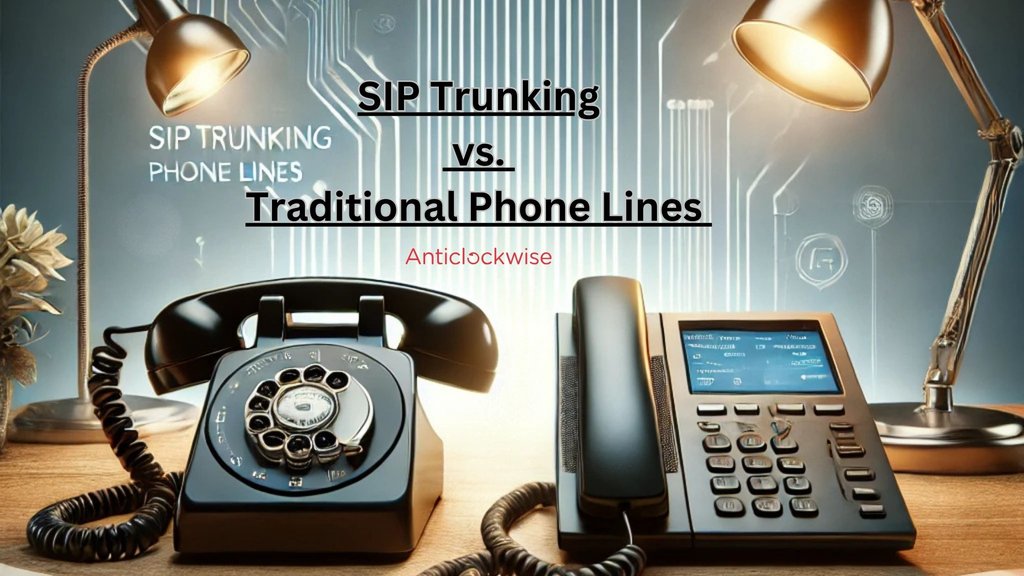
SIP Trunking vs. Traditional Phone Lines: Why Businesses Are Switching
In today's world, there is a very salient decision that must be made by organisations for their communication systems: either to continue using traditional phone lines or shift to SIP trunking. And still-in-use old technologies, like Public Switched Telephone Network (PSTN) or analog, have been in practice for decades for some companies. The advent of SIP trunking is presenting a new way of doing voice business, thus changing how an organisation uses voice communication.
This article will discuss standard phone lines versus SIP trunking, discussing specification differences in cost-effectiveness, scalability, and advantages relative to making SIP trunking the best option available to businesses that want to enhance their communication infrastructure. Let's look at the reason businesses are adopting this innovative solution.
The Fundamentals: SIP Trunking vs. Traditional Phone Lines
How Traditional Phone Lines Work
Traditional phones were connected to the Public Switched Telephone Network (PSTN) using copper wires. This system has been adequate for businesses for centuries, but now it bears some deep-down shortcomings in the current digitally-driven setting.
Another major drawback is dependence on fixed lines, which restricts scalability. New lines are required to be added or disconnected that involve physical changes, resulting in interruption of services and added charges. A case in point is flexible organisations that can no longer prefer fixed lines as they suffer under the burden of growth or demand changes.
Moreover, a message would cost a lot of money if transmitted through the additional long-distance phone lines for long-distance services rendered, which makes it less affordable for globalising businesses. Heavy damage is caused to them because of reliance on fixed infrastructure, and therefore they are even more sensitive to outages and maintenance problems. Hence, their reliability suffers.
Modern systems require some contemporary alternatives as technology advances, drawing out barriers in analog systems.
How SIP Trunking Works
Otherwise known as Session Initiation Protocol trunking, SIP trunking revolutionises communications, taking voice and other data and placing it over an Internet Protocol (VoIP) connection. SIP trunks replace traditional hard-wired voice lines and allow several virtual phone lines to terminate in a single broadband connection without the need for physical infrastructure.
It is a great flexible and scalable new strategy for businesses. Organisations can scale their communications capacity up or down as required - increasing line usage during busy seasons or reducing line usage during slower periods. SIP trunking has entered the operations and transformed them into the cost-efficient uses of less investment-extensive physical infrastructures; hence being a game-changer for organisations with low practicality and costing.
Key Advantages of Switching to SIP Trunking
Cost Savings and Efficiency
Above all, enterprises shift towards SIP trunking because of the high probability of significant reductions in telecom costs. Costly line rentals, and high rates charged per unit for long-distance and international calls are common characteristics of traditional phone systems. SIP trunking transfers voice communications via the internet, therefore, abolishing the much-dreaded physical lines within which the calls can travel and lowering the costs manifold.
SIP trunking is a revolutionised form of voip-based telecommunication technology designed to give excellent cost-saving solutions for businesses amid increased international mobility since customers who share the same infrastructure can use it to leverage their current accounts into a single unified bill for cost recovery in a repeated-aggressive manner. It enables distance and international calling at a very minimal price.
Scalability and Flexibility
In the global economy today, flexibility and scalability are essential, and SIP trunking is adequate for delivering flexibility and scalability. It can easily change the communication structure and add or delete lines as needed-without physical installations or service interruptions. SIP trunking is therefore the best choice for an expanding enterprise aiming to penetrate new markets, open new locations, or downscale its operations.
SIP trunking, unlike traditional telephone lines, can modify provisions through simple software configurations, resulting in minimal disturbance. It also easily integrates with unified communications solutions and customer relationship management (CRM) systems to promote seamless processes and improved operational efficiency.
Features and Functionality: Modernizing Business Communications
Enhanced Features and Integration
Advanced features go beyond mere voice calls; they improve productivity and customer service and include the following:
- Direct Inward Dialing (DID): This feature allows a number assigned to an employee, so it is direct access to the employee without any operator assistance.
- Number Portability: Changing over to SIP trunking does not mean losing existing numbers. Companies can retain their current numbers, ensuring continuity for clients and partners.
- Unified Communications integration: SIP trunking can integrate well with those platforms that can combine voice, video, messaging, and file-sharing activities in a centralized hub for collaboration.
Features not only modernize business communication but also improve customer experience by being more available, in touch, and efficient between employees, thus making workflows easy across the organiaation.
Enhance Connectivity with SIP Trunking!
Enjoy the benefits of high-quality voice services and reduced costs with our reliable SIP trunk solutions.
Improved Business Continuity and Disaster Recovery
SIP trunking can lay the foundation to reliable solutions for business continuity and disaster recovery, wherein communication goes on even during downtimes or emergencies. In the case of outages, SIP systems can automatically forward calls to mobile phones, alternative offices, or remote employees, irrespective of whether outages are caused by technical difficulties or natural disasters.
This capability is especially salient to businesses with remote work forces or those where downtime can equate to significant dollars lost from the bottom line. SIP trunking, unlike traditional phones lines, which rely heavily on physical infrastructure, ensures a strong, versatile approach to keeping customer service operational and efficiency intact, even when everything else is down.
Some of the technologies that are 'indispensable' in today's environment are VoIP and SIP trunking as companies work to increase efficiency, cut costs and be competitive in future business. Nowadays, traditional phone lines have not provided for the demands of modern businesses despite having proven reliable in a past business environment.
This new technology is transforming the way of business communication from a converged voice, video, and messaging end to a fully connected future. SIP trunking provides savings, scalability, enhanced features, and integration with cloud-based phone systems and unified communication platforms.
Time to consider making the switch from all the traditional phone lines still in use. Enjoy flexibility, cost savings, reliability, and much more in communication with SIP trunking.
Anticlockwise has proven itself the leader toward competing by moderniaing her communication infrastructure; therefore, reach out to it, we will consult on how SIP trunking can specifically suit your business needs. Reach us today and take the step onto a more efficient future-ready communication system.

Managing Director
